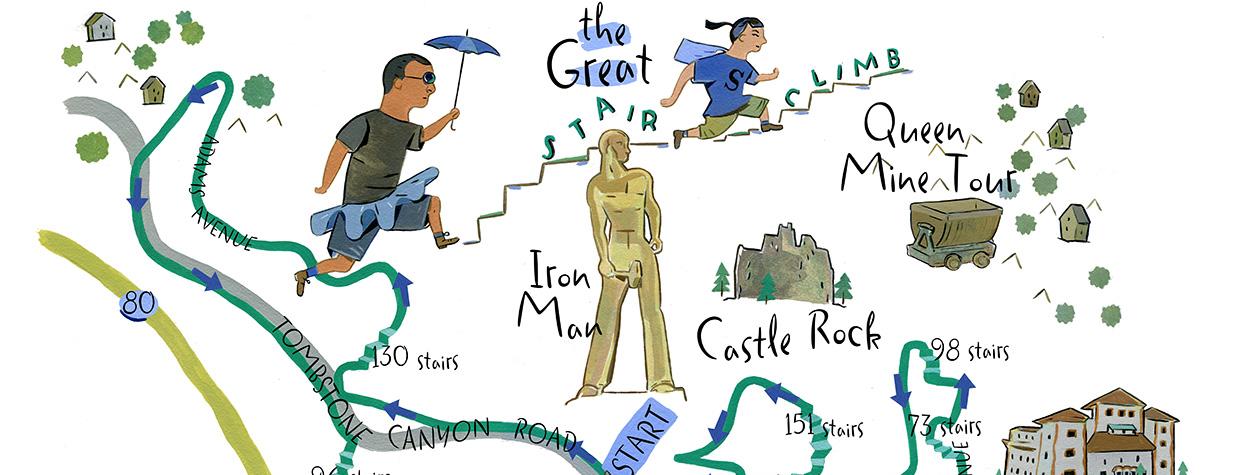Let’s say you’re a pretty good runner who’s looking for a new challenge, so you sign up for a race in Bisbee that bills itself as a 5K (3.1 miles). But then you learn that Bisbee is more than a mile above sea level. And that the race, it turns out, actually is more like 4.5 miles. And that runners climb nine steep, narrow staircases built nearly a century ago to replace the mule trails that once ran through this old mining town. And that when you arrive, wheezing, at the base of one trio of staircases in the middle of the race, you’ll face an elevation gain of more than 500 feet — and after that, you’ll have to run, and climb, even more.
“If you make the mistake of looking up, you’ll probably ask yourself why you’re doing it,” says Cynthia Conroy, who founded the Bisbee 1000 back in 1990. Luckily, most people who enter this unique race have some idea of what they’re getting into — and on Saturday, October 16, those runners will descend on Bisbee to mark the event’s COVID-delayed 30th anniversary. “I always tell people it’s kind of like an adventure,” Conroy says. “It was created and embraced long before things like mud runs and obstacle courses.”
Conroy, a Florida native, was in grad school in California around the time running became a national fitness phenomenon. By the 1980s, when she was living in Bisbee, a new craze was sweeping the gyms: step aerobics. And in 1989, she saw a New York Times article about people using stair-climbing machines. It was a lightbulb moment, given that Bisbee has some 33,000 concrete stairs. Conroy started walking around town and envisioning a race that incorporated some of the staircases; over several months, she says, “the course revealed itself,” and it became what’s thought to be the first outdoor event of its kind.
While the Bisbee 1000 climbs only a fraction of the stairs in Bisbee (the total for this year’s race is 1,032), it does include some of the town’s best-known landmarks, from the “Iron Man” statue at the start line to the historic downtown and Brewery Gulch. The course has evolved over the decades, and that’s mirrored the evolution of Bisbee itself, from a sleepy mining town and artists’ haven to a vibrant tourist destination. Residents have embraced the event, and many of them gather on porches to party and cheer on runners, who range in age from 7 to 80-plus. (Some of those runners sport elaborate costumes that may or may not be ideal for climbing stairs.)
The inaugural race had 200 people; then there were 400, then 650. The growth continued until the 20th annual race, during which some of the 2,100 runners grew frustrated with long lines at the staircases. This year’s sold-out event is capped at about 1,500 participants, and Conroy says she plans to reduce that to 1,000 next year to further alleviate congestion. And while many early participants were Bisbee residents, fewer than 1 percent of runners today are locals; most of the rest are from Phoenix, Tucson and elsewhere in Arizona, but a handful come from out of state. Many have run multiple Bisbee 1000s, and some have built family reunions or birthday parties around the event. One couple even got engaged during the awards ceremony after the race.
If you’re running in this year’s race and have dreams of breaking the 30-minute mark — which, fair warning, has happened only once in the event’s history — or at least winning your age group, Conroy offers this tip: Use your arms as much as your legs on the stairs. “A very elite athlete can run up these stairs, but everyone else is probably only running up the first two,” she says. But most of the staircases have double handrails, and if there aren’t too many other runners nearby, you can hoist yourself up like a cross-country skier working their poles. It might also help to visualize the finish line — which this year is at Higgins Hill Park, the site of a new fitness court that Bisbee Vogue Inc., the nonprofit group Conroy founded to operate the race and other ventures, partnered with the city to create after the pandemic forced the cancellation of last year’s event.
But don’t feel left out if you aren’t one of the lucky ones running the Bisbee 1000 this year: The entire course is public, and you can give it a try anytime. Maybe you’ll find it easier than it sounds. Or maybe you won’t. “We’ve had marathoners who’ve done it and said it was tougher than the marathon they did two weeks before,” Conroy says. “Whether you do it in half an hour or two hours, it’s just a delightful challenge, no matter what your fitness level is.”
For more information, visit bisbee1000.org.

